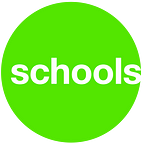Standing in Common Cause with our Nation’s Children
By Chad Soleo, Chief Executive Officer of Green Dot Public Schools
COVID-19 and the protocols and policies that stemmed from the growing realities of pandemic life demanded that schools nationwide change our prevailing instructional delivery methodology overnight. Take this in: we all changed an educational model that’s been widely employed since the early 19th century — in a matter of weeks. We will certainly learn a lot about online learning, but it will be at the expense of quality instruction and ultimately, children’s learning today — especially those who find themselves on the wrong side of the digital divide. And make no mistake, the most impacted, as usual, will be those children who most need the support of schools. This is truly heartbreaking in light of the reality that those same families are disproportionately losing income as unemployment persists in its historically unequal fashion.
So how do we get our children back in school? We’re all familiar with the primary recommendations: limit class sizes, plan on a hybrid model of online learning and in-person learning, and adjust schedules so that not all students attend class on the same day. Both mean schools would need to hire more teachers to accommodate more classes and keep children home part-time. Schools are being asked to administer COVID-19 testing and temperature monitoring with tracing and follow-up, which requires building and paying for a health infrastructure that doesn’t exist today. Further, schools would require mask-wearing, which means we’ll have to provide them for our staff and our students — let alone the challenge of gaining compliance from middle-schoolers or the youngest children. Lunches are supposed to be consumed in classrooms instead of communal spaces, greatly increasing the complexity of supervision duties. Yes, these recommendations leave many questions outstanding — when and how should kids play sports? Do science experiments? Develop and nurture vital social skills? We all know compromises must be made to our ideal school building usage and programmatic plans.
We must ensure that parents feel they are sending their children into safe environments. Enter CDC, state, county and local health organization guidelines. In the context of our school system budgets, this is the brand new Personal Protective Equipment (PPE) line item which includes masks and face shields, hand sanitizer and dispensers, non-contact infrared thermometers, medical grade disinfectant and cleaning materials, aerosol blocking shields or barriers (PPB) for student desks and office stations, posters, handouts, video explainers and teaching materials to reinforce all safety protocols. It is still not clear where schools are supposed to drum up the money for these items. And, this doesn’t account for indirect cost related to securing, installing and distributing such equipment and information effectively, or the added personnel to meet such guidelines and implement a protocol for COVID-19 contact tracing and case investigation.
Green Dot, along with many of our like-minded public education advocates across the country, such as the National Education Alliance, Los Angeles and San Diego Unified School Districts, among so many others have arrived at the same conclusion: we cannot open safely — whenever that may be — without adequate resources. Make no mistake: educators, staff and school leaders are adaptable and nimble, and their work to serve students through this unprecedented crisis has been incredible. But, devotion and hard work are not a fiscal panacea. This leads to an even more dismal revelation: if schools do not receive additional resources and cannot reopen, our students’ education and socio-emotional development will continue to be put at great risk, and how many parents may not return to work?
Add in the expense of ensuring that every child is digitally connected — a Chromebook and wifi hotspot in the case of a Green Dot Public Schools student — and at least we’re one small step closer to a more equitable situation. But how do we meet the special needs of children with more personalized prescriptions in the context of Individualized Education Programs? And how do we as educators or the parents and children we serve even know how well we’re serving all without any calibrated assessments or outcomes to speak of?
Let’s not forget that in those communities like the ones Green Dot Public Schools exclusively serve, where the public school is disproportionately responsible for crucial non-academic needs, the issues are even more pronounced. These schools take on the responsibility of feeding students who qualify for free or reduced-price meals, counseling and referring students who navigate trauma with fewer supports in place outside the school, providing after-hours tutoring and enrichment activities for students who cannot be supervised at home for various reasons and/ or cannot afford to pay for such opportunities, testing vision and providing eyeglasses for children, and reporting abuse and neglect in the interest of child welfare.
Classes start in two weeks, mostly online at this point. Inaction by federal leaders and political horse trading by state leaders are treating public schools like any other public service. These are not just cuts to the budgets, these would be cutting the future and opportunities of our nation’s publicly-educated children — effectively cementing the unjust status quo of opportunity gaps for students of color without access to high quality public education in their community.
We have to do better. Today. Our children can’t wait.
